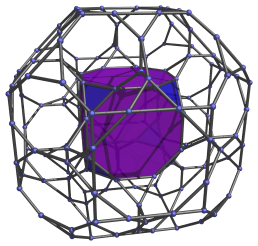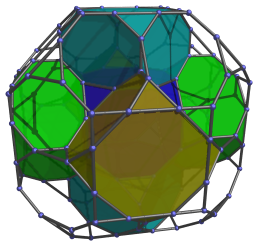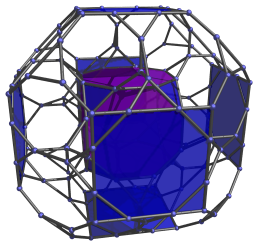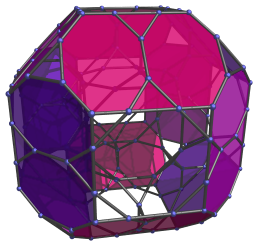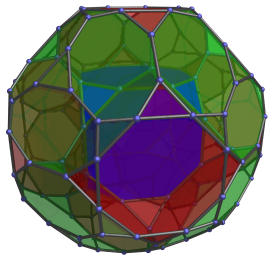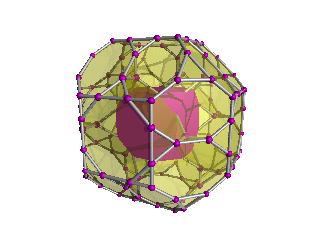Xylomesochoron (EntityTopic, 11)
From Hi.gher. Space
The xylomesochoron (also known as the bitruncated 24-cell) is the result of mesotruncating the xylochoron. It is unique in that, other than the simplices, it is the only mesotruncate (in any dimension) to be cell-transitive - it is bounded by 48 truncated cubes.
Structure
The following cell-first parallel projection of the bitruncated 24-cell shows the nearest cell to the 4D viewpoint.
The octagonal faces of this cell are joined to 6 other cells, shown in the following image:
These cells are arranged in a cubical arrangement.
The triangular faces of the nearest cell are joined to 8 other cells. The following image shows 8 cells surrounding the nearest cell.
These cells are arranged in an octahedral arrangement.
The 15 cells we've seen so far lie on the “northern hemisphere” of the bitruncated 24-cell. The next image shows 6 of the 18 cells that lie on the “equator”.
These equatorial cells appear to be flat squares because they are being viewed at from a 90° angle. In reality, they are perfectly uniform truncated cubes.
Together with the “north pole” and “south pole” cells, these cells correspond with the 8 cells of an inscribing tesseract. The next image shows these cells (minus the “south pole” cell, which lies behind the central cell in the fourth direction and is obscured from view here.
The next image shows the other 12 equatorial cells. These correspond with the 12 edges of a cube, or the faces of a rhombic dodecahedron.
Again, these cells also appear to be flat because they are being viewed at from a 90° angle. In 4D, they are perfectly uniform truncated cubes.
After these cells, we have the “southern hemisphere” cells, which mirror the arrangement of the northern hemisphere cells. Hence, we have a total of 1+6+8=15 northern hemisphere cells, 15 southern hemisphere cells, and 6+12=18 equatorial cells, for a total of 48 cells.
Projections
Perspective projection
The nearest cell is rendered in blue, the cells sharing an octagonal face with it in red, and the cells sharing a triangular face with it in green. The equatorial cells are not visible because they make an angle larger than 90° with the viewpoint.
Parallel projection
The central cell, highlighted, at the front of the 4D viewpoint, is a truncated cube, as are all cells in the icositetrachoric rectate. Around it are (a) 8 truncated cubes in the positions of the cube corners (the octants), and (b) 6 truncated cubes in the positions of the cube faces (the cardinal directions). Six more truncated cubes which cannot be seen in either image due to lying on the "equator" of the shape and thus becoming flattened in the projection are attached to these (b) cells. There are another 15 truncated cubes in a mirror image arrangement on the back of the 4D shape.
| Notable Tetrashapes | |
| Regular: | pyrochoron • aerochoron • geochoron • xylochoron • hydrochoron • cosmochoron |
| Powertopes: | triangular octagoltriate • square octagoltriate • hexagonal octagoltriate • octagonal octagoltriate |
| Circular: | glome • cubinder • duocylinder • spherinder • sphone • cylindrone • dicone • coninder |
| Torii: | tiger • torisphere • spheritorus • torinder • ditorus |
